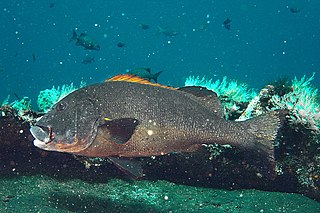
Plectorhinchus albovittatus, the two-striped sweetlips or giant sweetlips, is a species of marine ray-finned fish, a sweetlips belonging to the subfamily Plectorhinchinae, part of the grunt family Haemulidae. It is native to the Indian Ocean and the western Pacific Ocean.

Apogon imberbis, the cardinalfish, the Mediterranean cardinalfish or king of the mullets, is a species of ray-finned fish, a cardinalfish belonging to the family Apogonidae. It is widely distributed in the Mediterranean and along the warm temperate and tropical eastern Atlantic coasts from Portugal south to the Gulf of Guinea.

The piper gurnard, also known as the piper or the lyre gurnard, is a species of marine, demersal ray-finned fish from the family Triglidae, the gurnards and sea robins. It is found in the eastern Atlantic Ocean and the Mediterranean Sea. It is the only species in the monotypic genus Trigla.

The streaked spinefoot, also known as the Java rabbitfish, blue-spotted spinefoot, blue-spotted trevally, Java spinefoot or white-spotted rabbit-fish, is a species of marine ray-finned fish, a rabbitfish belonging to the family Siganidae. It is found throughout most of the Indo-Pacific region.
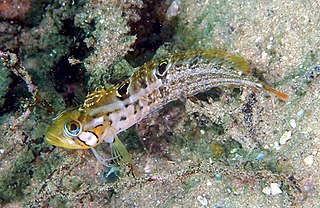
Clinus venustris, the speckled klipfish, is a species of clinid that occurs in subtropical waters of the Atlantic Ocean from Namibia to South Africa where it is found in the subtidal zone as well as being a denizen of tide pools. This species can reach a maximum length of 12 centimetres (4.7 in) TL. and feeds primarily on amphipods, isopods, mysids, and echinoderms.
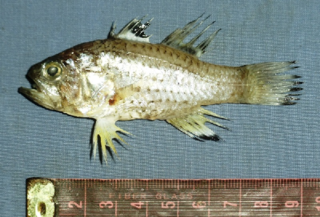
Jaydia is a genus of fishes in the family Apogonidae native to the western Pacific Ocean.

The blackfin slatey, also known as blackfoot sweetlips, blackfin sweetlips or blacktip sweetlips, is a species of marine ray-finned fish, a sweetlips belonging to the family Haemulidae. It is found in the eastern Indian Ocean and the western central Pacific Ocean.

The Indian Scad, also known as the Northern mackerel scad, round scad, Russell's mackerel scad, slender scad or the three lined grunter, is a species of ray-finned fish of the genus Decapterus which is part of the family Carangidae and which occurs in the Indian Ocean. It has colonised the eastern Mediterranean through the Suez Canal. It is an important species in coastal fisheries throughout its range.
Ozichthys is a monotypic genus of cardinalfish, which was named and characterized in 2014. Its sole species, Ozichthys albimaculosus, is found in tropical Australia and southern New Guinea.

Ostorhinchus capricornis, also known as the Capricorn cardinalfish, is a species of ray-finned fish, a cardinalfish from the family Apogonidae which occurs around reefs in the western Pacific Ocean.

Ostorhinchus fasciatus, commonly known as the broad-banded cardinalfish, is a marine fish native to the Indian and Pacific Oceans which is a Lessepsian migrant to the eastern Mediterranean through the Suez Canal from the Red Sea, it was first recorded off Israel in 2008 and has now reached the southern coast of Turkey. It has a number of vernacular names including barred striped cardinalfish, four-banded soldier-fish, striped cardinalfish and twostripe cardinalfish.

Sphyraena chrysotaenia, the yellowstripe barracuda, is a species of predatory, ray finned fish from the family Sphyraenidae which is found in the Indo-West Pacific region. It has entered the Mediterranean Sea from the Red Sea through the Suez Canal as a Lessepesian migrant and is now an important species in the fisheries of the eastern Mediterranean.
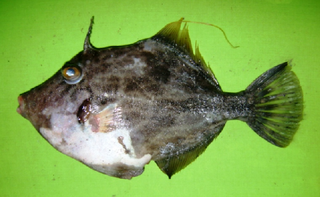
Stephanolepis diaspros, commonly known as the reticulated filefish or the reticulated leatherjacket, is a species of bony fish, a ray-finned fish in the family Monacanthidae. Its natural range is the western Indian Ocean but it is also one of the species which has colonised the Mediterranean through the Suez Canal by Lessepsian migration from the Red Sea.

Jaydia smithi, Smith's cardinalfish, is a species of ray-finned fish from the Indian and Pacific Oceans, a member of the family Apogonidae. It has colonised the eastern Mediterranean Sea by way of the Suez Canal since 2007.

Cheilodipterus novemstriatus, the Indian Ocean twospot cardinalfish, is a species of ray-finned fish from the Indian Ocean, which is a member of the family Apogonidae. It has colonised the eastern Mediterranean Sea by way of the Suez Canal since 2011.
Apogonichthyoides pharaonis, the Pharaoh cardinalfish, is a species of cardinalfish from the family Apogonidae which is found the western Indian Ocean and Red Sea. It is one of a group of species which have colonised the eastern Mediterranean Sea from the Red Sea via the Suez Canal, a process known as Lessepsian migration.
Equulites klunzingeri, or Klunzinger's ponyfish, is a marine, demersal species of ponyfish from the family Leiognathidae which was originally found only in the Red Sea. It is colonizing the Mediterranean as part of the Lessepsian migration through the Suez Canal.
Oxyurichthys petersii, commonly known as Peters' goby, is a species of ray-finned fish, a goby, from the family Oxudercidae. It is native to the Red Sea, and has now colonised the eastern Mediterranean Sea by Lessepsian migration through the Suez Canal.
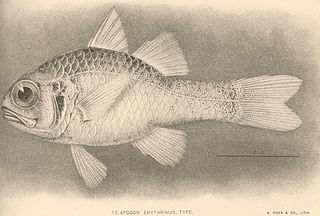
Apogon erythrinus, also called Hawaiian ruby cardinalfish, is a marine fish species endemic to Hawaii. It belongs to the family Apogonidae and the subfamily Apogoninae.

Pterygotrigla polyommata, the latchet, butterfly gurnard, flying gurnard, lachet gurnard, pastry, sharpbeak gurnard, spiny gurnard or spinybeak gurnard, is a species of marine ray-finned fish belonging to the family Triglidae, the gurnards and sea robins. It is found in the southeastern Indian and southwestern Pacific Oceans.
















